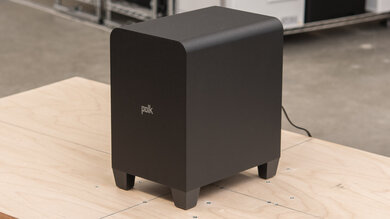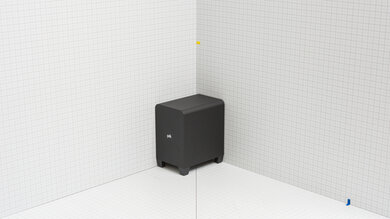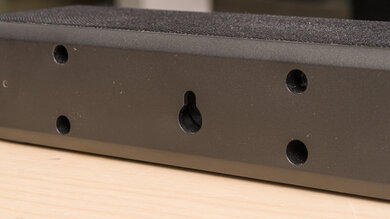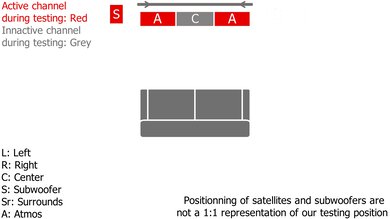The Polk Audio Signa S4 is a 3.1.2 setup released in 2021. It's the higher-end bar in Polk's Signa Series, and unlike the Polk Audio Signa S2, it supports Dolby Atmos content. Its slightly V-shaped sound adds extra punch in the bass and brightness in the treble to your favorite music. Dialogue still reproduces very clearly, and there's even an adjustable dialogue enhancement feature that lets you control how loud voices sound in the mix. However, it lacks a thumpy low-bass, so you don't feel the excitement in action movies and bass-heavy music.
Our Verdict
The Polk Audio Signa S4 is fair for mixed usage. Its slightly V-shaped sound adds extra punch in the bass and brightness in the treble to your favorite music. Dialogue reproduces quite clearly and accurately, too, and its adjustable dialogue enhancement feature is handy for listening to TV shows and podcasts. Also, it supports Dolby Atmos content. However, the lack of low-bass takes away from the immersive feeling in action movies, and its surround sound performance isn't the most impressive.
- Bass adjustment feature.
- Adjustable dialogue enhancement feature.
- Lacks low-bass.
- Downmixes surround sound into stereo.
The Polk Audio Signa S4 is satisfactory for dialogue-centric content like TV shows and documentaries. It's a 3.1.2 setup with a discrete center channel that helps anchor voices to a pinpoint location in the soundstage. You can even make voices more clear and crisp using its adjustable dialogue enhancement feature - which Polk calls VoiceAdjust. The Night Mode tool is handy, too, since it reduces the bass and increases the volume of the voices to help you hear dialogue clearly at night.
- Adjustable dialogue enhancement feature.
- No Wi-Fi, Chromecast, or AirPlay support.
The Polk Audio Signa S4 is fair for music. Out-of-the-box, it has a slightly V-shaped sound profile that adds a little extra punch in the bass and some brightness in the treble range. Vocals and lead instruments are clearly and accurately reproduced, and higher-pitched instruments sparkle with brightness. You can customize its sound a bit with its bass adjustment feature. However, it can't reproduce the deep thump and rumble in the low-bass found in bass-heavy genres like hip-hop and EDM.
- Bass adjustment feature.
- Bluetooth-compatible.
- Lacks low-bass.
- No treble adjustment.
The Polk Audio Signa S4 is okay for movies. It supports Dolby Atmos content with two up-firing drivers built into the bar itself. The performance is pretty good given its price point, but you notice the lack of low-bass in action-heavy scenes. It can also playback surround sound content like Dolby Digital, but the performance isn't the best. Without dedicated surround channels, it has to downmix this content into stereo to play it.
- Bass adjustment feature.
- Adjustable dialogue enhancement feature.
- Lacks low-bass.
- Downmixes surround sound into stereo.
Changelog
- Updated May 12, 2025:
We've added the Polk Audio Signa S4D as a variant in the 'Differences Between Variants' box of this review.
- Updated Jan 29, 2024: Updated text in Stereo Dynamics, Audio Latency: ARC, and Audio Latency: Optical boxes with new methodology from TBU 1.3.
- Updated Jan 29, 2024: We've converted this review to Test Bench Update 1.3. If applicable, we've retested stereo sound based on the manufacturer's recommendations. Additionally, we've expanded our audio latency tests to the following boxes: Audio Latency: ARC, Audio Latency: HDMI In, and Audio Latency: Optical. You can see the full changelog here.
- Updated Sep 01, 2023: Added market comparison with the Polk Audio Magnifi Max AX SR in the Style - Satellites box.
Check Price
Differences Between Sizes And Variants
The Polk S4 is available in Black. You can see the label for the bar here. There's also the Polk Audio Signa S4D variant, which features a design refresh, with no change to the features and performance.
If you come across another version of this soundbar, let us know in the comments, and we'll update the review.
Popular Soundbar Comparisons
The Polk Audio Signa S4 is a 3.1.2 setup that offers a more affordable alternative to other Atmos bars on the market. Its Atmos performance is comparable to similarly-priced bars like the Sonos Beam (Gen 2), but it doesn't offer the same immersive sound as more premium setups. There's also a lack of low-bass that takes away from the thump and rumble in movie scores and action-filled scenes, which is a bit unfortunate. If you're on a budget, it's still a fairly versatile bar.
See also our recommendations for the best soundbars under $500, the best Dolby Atmos soundbars, and the best soundbars.
The Sonos Beam (Gen 2) is better than the Polk Audio Signa S4. The Sonos is a 5.0 setup with a small, compact design and is ideal if you don't have a lot of space. Despite its small size, it has better soundstage and surround performances than the Polk. It also has additional features, like room correction and built-in voice assistant support.
Depending on your listening habits, you may prefer either the Polk Audio MagniFi MAX SR or the Polk Audio Signa S4. The MAX SR is a 5.1 setup that comes with dedicated satellites, and it has a better surround sound performance. However, it doesn't support Dolby Atmos content like the Signa S4. Also, the MAX SR reproduces a lot of compression and distortion, especially in the bass range, that affects the sound of your audio.
The JBL Bar 5.1 Surround is a bit better for mixed usage than the Polk Audio Signa S4. The JBL is a 5.1 setup with a better surrounds performance. It can reproduce a more extended low-bass, and it also comes with more sound enhancement features, including room correction. That said, the Polk is still a pretty versatile 3.1.2 setup. It has a better soundstage than the JBL, and it even supports Dolby Atmos content.
The Polk Audio Magnifi Max AX SR is better than the Polk Audio Signa S4. The Max AX SR is a better-built soundbar with discrete satellites to improve its surround sound. It gets louder, too, and it offers a more extended low-bass. You have more wireless playback options, too.
Test Results

The Polk Audio Signa S4 has a pretty similar design to the Polk Audio Signa S2. Both bars are mostly plastic, with fabric covering the front of the bar. On the S4, fabric covers the entire top of the bar, too.
The sub looks a bit different than the one that comes with the Polk Audio Signa S2. It's mostly melamine, and unlike the S2, there's no fabric on the sub. It also sits on four pegs, and the port is underneath.
Unlike the Polk Audio Magnifi Max AX SR, this bar doesn't include satellites.
The Polk Audio Signa S4 has a satisfactory build quality. The bar itself is mostly plastic, which doesn't feel very premium. However, the fabric on the front and the top of the bar is tight and thick, so it doesn't seem like it rips easily. The subwoofer's melamine build feels more solid than the Polk Audio Signa S2, too.
The Polk Audio Signa S4 has a satisfactory stereo frequency response. Its sound profile is V-shaped, meaning that there's a touch of extra boom in the bass and some extra brightness in the treble that makes vocals and lead instruments sparkle. Dialogue in movies and TV shows is clear and accurate, thanks to the balanced mids. If you like to listen to bass-heavy genres, you'll notice the lack of low-bass since you don't feel the deep thump and rumble on these tracks.
The Polk Audio Signa S4 has a bass adjustment feature to help you customize its sound. When you set it to '-3', the sound profile is more neutral and balanced. Vocals and lead instruments are clear and detailed in the mix. There's still a little extra punch in the mid-to-high bass range; it's less noticeable than with its default sound. That said, bass adjustment features can't make up for the lack of low-bass, so you're still missing the deep rumble in bass-heavy music genres.
The Polk Audio Signa S4 has a decent soundstage. It's perceived to be about as wide as the bar itself, but it doesn't have any tricks to make it seem wider than that. On the upside, it gives a good sense of height, even with music, so the soundstage seems to reach up over your TV screen. The focus is good, too. For example, if you're listening to an orchestra, each instrument seems to come from an accurate, pinpoint location in the soundstage.
The Polk Audio Signa S4 has decent stereo dynamics. It can get loud enough to fill an average-sized living room with sound. If you have a larger space or want to crank up the volume for parties, it doesn't get loud enough for these uses. Fortunately, when you push it to max volume, there isn't much compression.
The Polk Audio Signa S4 has a good center channel performance. It's a 3.1.2 setup, meaning that it comes with a discrete center channel. This helps anchor voices to a pinpoint location in the soundstage, so dialogue is clearly and accurately reproduced.
The Polk Audio Signa S4's surround performance is poor, but that's normal for 3.1 soundbars. The bar doesn't come with dedicated surround speakers. Instead, it has to downmix surround sound into stereo to play it. Unfortunately, this doesn't sound as immersive. Audio seems like it's coming from speakers placed in front of you rather than from speakers placed all around you.
The Polk Audio Signa S4 has a middling Atmos performance. There are two up-firing drivers built into the bar itself, which ricochet sound off the ceiling to create the illusion of height. The bar does a good job simulating height, meaning drones seem to fly overhead from clear and accurate locations around you. The lack of low-bass is noticeable, especially with action-packed scenes and high-intensity explosions. It doesn't provide the same immersive feeling as more premium setups like the Bose Smart Soundbar 900 or the Sony HT-A9. But, ultimately, it offers a comparable performance to other Atmos bars in this price range, like the Sonos Beam (Gen 2) and the Vizio M Series M512a-H6.
The selection of sound enhancement features for the Polk Audio Signa S4 is pretty limited. As expected with bars in its price range, you don't find premium sound enhancement features like room correction. There's a dialogue enhancement feature - which Polk calls VoiceAdjust - and it lets you choose between three different volume levels for the voices in your audio. The Night Mode feature is ideal for watching TV at night since it lowers the bass and increases the dialogue's volume to help you hear every word without bothering anyone around you. However, if you want to customize its sound, there aren't many options besides its bass adjustment feature and its two EQ presets: Music and Movie.
There's a pretty limited selection of inputs on the Polk S4. You can connect the bar to your TV with its optical or HDMI ARC inputs. You can also play music on the bar from other sources using its 3.5mm AUX input or its USB input for flash drives. However, you won't find an HDMI In port for video passthrough.
The Polk Audio Signa S4 has excellent audio format support via ARC. It supports some of the most common surround sound formats, including Dolby Digital, and lossless and object-based formats like Dolby Atmos. Unfortunately, there's no support for DTS content.
Over Optical, the Polk Audio Signa S4 supports Dolby Digital, the most common surround sound format used on Blu-rays and streaming platforms. There's no DTS support, though.
Audio latency over an ARC connection is great. The audio you hear is in sync with the video you see with lots of common audio formats, from Dolby Digital to Dolby Atmos. Some apps and TVs compensate for latency differently, though.
Audio latency is on the higher end over an Optical connection, especially with Dolby Digital content. As one of the most common surround sound formats, you'll likely come across it on many different streaming platforms and Blu-rays. Some apps and TVs compensate for latency differently, but if you have issues, try switching to an ARC connection for better results.
The Polk Audio Signa S4 only supports Bluetooth connectivity. You can wirelessly stream audio from your phone or tablet to the bar over Bluetooth.
The remote is small and straightforward, providing easy access to all the bar's features. You can adjust the volume, change the input, and add or subtract the amount of bass. The three numbered buttons at the bottom of the remote let you choose between the three levels of dialogue enhancement. Above that, you find the buttons for the Music and Movie EQs as well as the Night Mode feature.




































